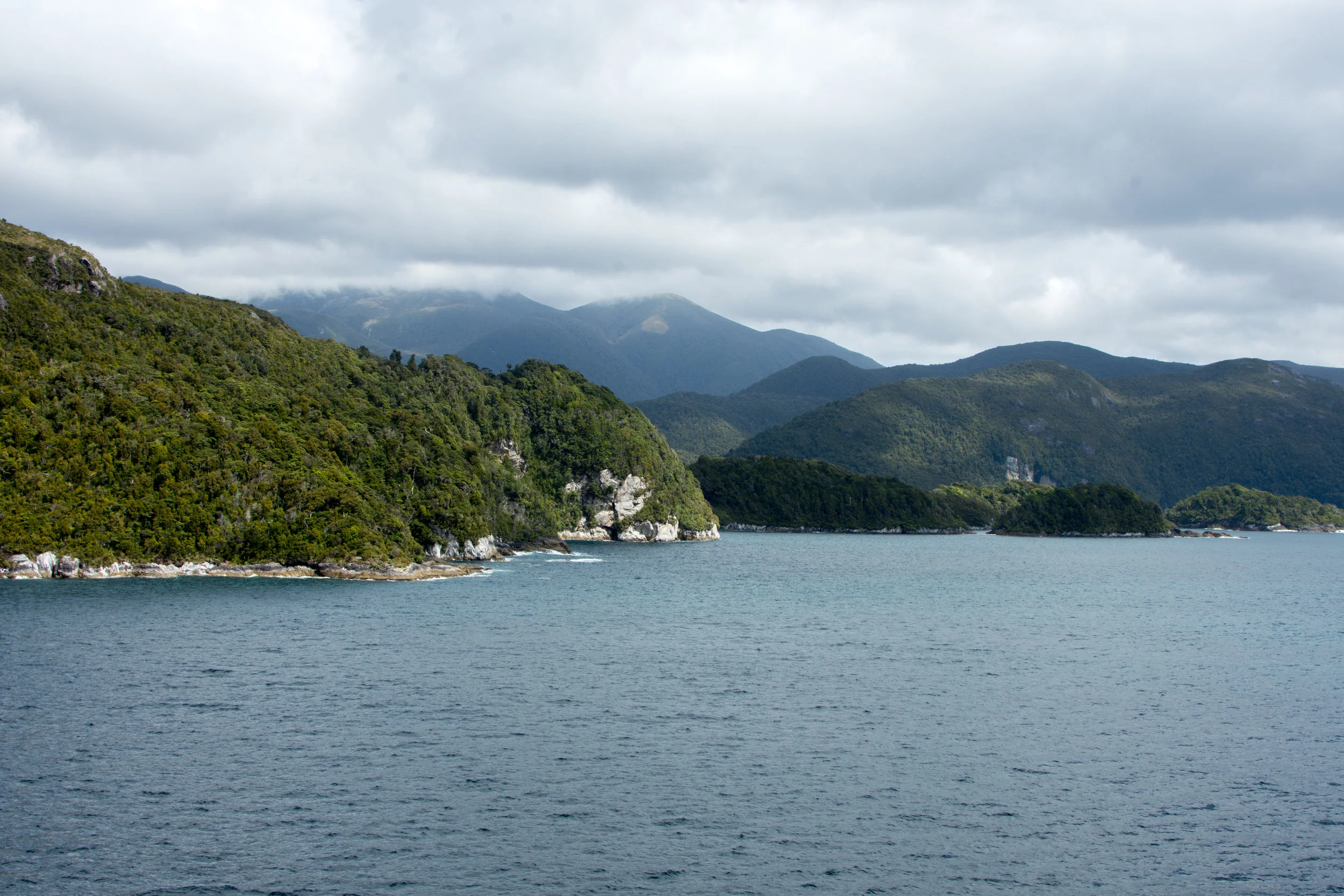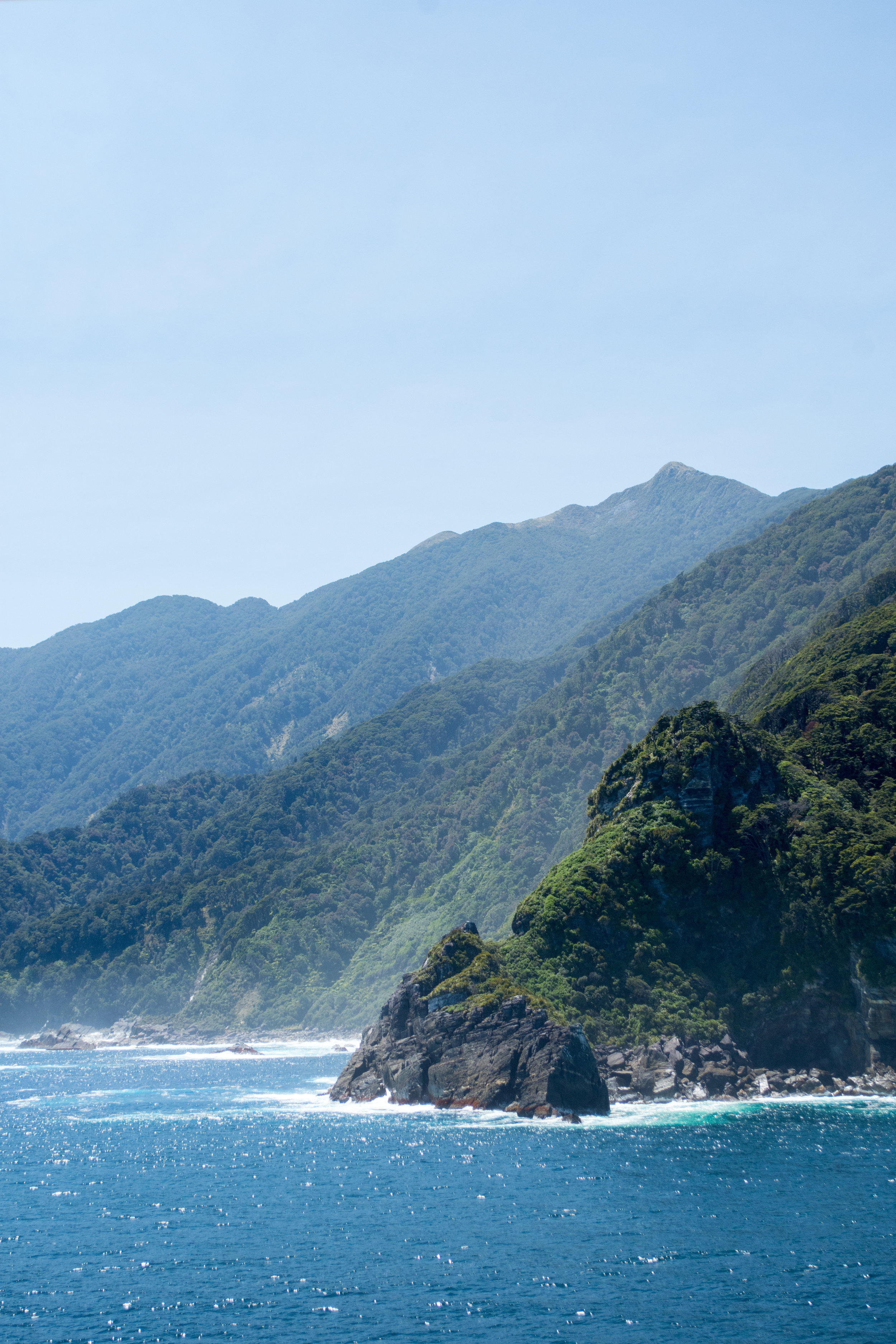Cruising the New Zealand Sounds on a Cruise Ship
THIS POST MAY CONTAIN AFFILIATE LINKS. WHEN YOU CLICK ON THESE LINKS WE RECEIVE COMPENSATION, AT NO EXPENSE TO YOU, THAT HELPS THIS BLOG RUN. ALL OPINIONS ARE OUR OWN.
The highlight of any cruise to New Zealand is sailing through the stunning Sounds – Milford Sound, Doubtful Sound, and Dusky Sound. The New Zealand Sounds are located at the southwestern end of New Zealand’s South Island and are part of the Fiordland National Park. The Fiordland National Park is filled with a dozen of both long and short fjords accompanied by snow-capped peaks, gorgeous waterfalls, and glacier-carved valleys. You don’t even have to leave your balcony to spot dolphins in the water below or be amazed by the striking height of the fjord walls. Here we show just how magical a day exploring New Zealand’s fjords can be and how to make the most of your trip.
New Zealand’s Fiordland National Park
Some describe Milford Sound and Fiordland National Park as the 8th Wonder of the World. It is hard to counter that accolade. Fiordland National Park covers 1.2 million hectares of New Zealand’s sound island and encompasses a dozen fjords, surrounded by mountains, lakes, and rainforests. If exploring the Fiordland from land, you can choose among numerous specular hiking trails that take you along the fjords and through the wilderness, meeting many of the rare species in the area.
Carved by retreating glaciers, the 15 fjords that make up the national park each have the characteristic steep cliffs. The mountains in the area make up the southern range of the Southern Alps.
The most popular fjord is Milford Sound, by far. Along with the large cruise ships that pass through Milford Sound early in the morning, dozens smaller boats, kayaks, and tourists frequent the fjord daily. The only other fjords accessible by roads are George Sound, Doubtful Sound, and Dusky Sound. While you can visit Milford Sound by road, there is something remarkable about entering the fjord from the sea.
Doubtful Sound
Dusky Sound
What is the Difference between a Sound and a Fjord?
So we’ve been intermittently using both Sound and Fjord to explain the same thing – a narrow water inlet with steep cliffs. But are they actually the same thing?
Fjord is a Norwegian word and some of the most famous and spectacular fjords can be found in the Scandinavian region. Fjords were formed by glaciers that caused erosion of the rocks below. It has a shallow mouth, where it opens out to the sea, and the deepest part is found inland, where the glacial forces were the strongest.
A sound is typically described as being wider than a fjord and does not have to be created by a glacier. Most are created from the ocean invading into a river valley – by either a rise in sea level or sinking land (or both).
So then, why do we keep interchanging sound and fjord, you ask. Because Milford Sound and the other sounds in New Zealand are actually fjords geologically. The fjords in this area were called sounds by European settlers and the names stuck.
Princess Cruise Ship in Milford Sound
Which Cruises go to the Sounds?
New Zealand’s popularity as a cruise destination has been skyrocketing in recent years, growing by 13% every year. New Zealand cruises typically depart either from Sydney, Australia or from Auckland. Along with Fiordland, New Zealand cruises typically visit Bay of Islands, Wellington, Tauranga, Napier, Picton, and Dunedin. Popular itineraries typically are either a round-trip from Sydney, a round-trip from Auckland, or a one-way trip from Sydney to Auckland (or vice versa). New Zealand’s cruise season lasts from October – April, during the southern hemisphere’s summer.
While not all New Zealand cruises visit the sounds, most 8+ night New Zealand cruises will visit Fiordland National Park.
The top New Zealand cruise lines and ships are (in order of price – lowest to highest):
Norwegian Cruise Line – Norwegian Jewel
Royal Caribbean – Radiance of the Seas, Ovation of the Seas
Princess Cruises – Golden Princess, Ruby Princess, Sea Princess, Majestic Princess
Celebrity Cruises – Celebrity Solstice
Viking Ocean Cruises – Viking Spirit, Viking Sun
Silversea Cruises – Silver Muse
Princess Cruises offers the most itineraries each year, giving you the most flexibility on other ports and departure dates.
How to Spend Your Day
The day at Fiordland National Park is technically considered a sea day. There are no excursions and you cannot leave the ship. Instead, the ship slowly cruises through the three sounds, staying close by the shore the whole day. You’ll know the times the ship will enter and leave each of the fjords beforehand and most captains do well at sticking to the schedule. Announcements will be made in the common areas for updates on the schedule and what to look out for while in each fjord.
Stirling Falls at Milford Sound
This is the cruise where a balcony room is extremely valuable. You don’t even have to leave your room to enjoy the scenic views around you. Typically, the first fjord you visit, Milford Sound, will be early in the morning (it is also by far the most beautiful). Cruise ships enter Milford Sound and turn around, so you will not miss either side of the fjord if you stay in your balcony. You will also beat the crowds of people trying to take photos on the top deck. You cruise through (entering at one point, exiting at another) both the Doubtful and Dusky Sounds, so staying in your balcony would potentially limit your ability to see both sides of the fjord. When booking your cruise, choose the side for your balcony based on the route you are taking around New Zealand for the rest of the trip. While you may not be able to see the shore for the entire cruise, pick the side that will is facing land. We traveled along the right side of the country going up from the South Island to the North Island, so we got a left or port side balcony.
Milford Sound
Doubtful Sound
When out on your balcony or up on the top deck, bundle up. It is typically quite chilly and rainy in the fjords. Be sure to check the weather before venturing out.
When the ship is not in a fjord, explore the parts of the ship that offer views of the coastline. Run on the treadmill facing the large windows in the gym, get a spot by the windows in the buffet, play mini golf, or rock climb. Most cruise lines typically invite a fjord expert on board to give a talk about New Zealand’s Fiordland and its wildlife at some point in the day.
Milford Sound
Milford Sound is considered the jewel of the New Zealand fjords and is by far the most accessible for both cruise passengers and land tourists. According to Maori legend, Tu-te-raki-whanoa carved all of New Zealand’s fjords, starting in the south. By the time he reached the northern Milford Sound (Piopiotahi), he had perfected his technique and made the perfect fjord. Upon hearing about Milford Sound’s completion, Hine-nui-te-po, the goddess of the underworld, worried that people would be so infatuated with the fjord they would never want to leave – so she released the sandflies into the sound. Fortunately, you will not have to deal with any sandfly infestation while on a ship.
When the ship first enters the fjord, you will pass Anita Bay to the right. Anita Bay is famous for its Jade, or what New Zealanders call greenstone. If you have good binoculars, you will see green-tinted pebbles along the beaches in the area. All of the jade along this beach have belonged to the Maori people for thousands of years, who use it in their jewelry. On the left side of the fjord is seal rock – which typically has many, you guessed it, seals sunbathing.
Bowen Falls in Milford Sound
Along with its stunning high mountain cliffs that plunge into the water, Milford Sound also has multiple waterfalls. The most popular are Stirling Falls, Bridal Veil Falls, and Bowen Falls. The first two you will see are Stirling Falls and Bridal Veil Falls. Typically, the cruise ship stops here and makes a 360º spin to give passengers situated at all parts of the ship a great view of these stunning waterfalls and a view down the rest of the fjord.
Stirling Falls at Milford Sound
As you venture more into the fjord, you will start to see more boats and kayakers around the edges of the fjord. At the end of the fjord, the most inland point, you’ll see a small town with road access, where small boats and helicopter tours depart from. You will also find Bowen Falls, Milford’s highest and most powerful waterfall. Once again, the cruise ship will start to turn around but will make a 180º turn and head out of the fjord.
Exiting Milford Sound
Dolphins at Milford Sound
As you are exiting Milford Sound, get out at the front of the ship and look for dolphins. This will be your highest chance of seeing dolphins on your trip – although you can see them at any point of your New Zealand cruise. We watched one large pod of dolphins jumping about out front of the cruise ship.
Doubtful Sound
Unlike Milford Sound, you will not see a city, roads, or any signs of human activity while cruising through Doubtful Sound. This large and deep fjord provides an atmosphere of peace and solitude with this breathtaking beauty. The cruise ship travels through Doubtful Sound, exiting at a different point back into the sea. The full Doubtful Sound fjord has three distinct arms branching off from the main fjord around Secretary island. The most inland sections of Doubtful sound is too narrow for the cruise ship to journey into and then turn around. Most of the large waterfalls are unfortunately found in the arms of the fjord but might be able to be seen from afar on the ship.
Be on the lookout for wildlife while sailing through Doubtful Sound. You might be able to spot more bottlenose dolphins jumping along the ship, and fur seals and crested penguins on the small islands in the fjord.
Doubtful Sound
Chances are, your cruise ship will be the only boat in Doubtful Sound, however, there are the occasional small boat tours that venture out to Doubtful Sound.
Dusky Sound
Dusky Sound is the most remote and least visited of the fjords that cruise ships travel to. It was named by Capitan James Cook as he first sailed to it at dusk in 1770. At 25 miles long, it is also the longest fjord you’ll visit with many complex parts. Dusky sound is filled with many large islands including Anchor Island, Long Island, and Cooper Island – on these you might be able to see seals, penguins, or other wildlife. In the waters, look out for whales and dolphins.
Dusky Sound’s striking fjord walls are covered in hundreds of waterfalls, which are especially astonishing when raining.























